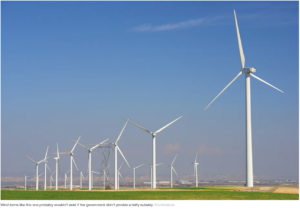So there we were driving back from Des Moines along I-80 on Sunday afternoon and did a casual survey of wind damage after the recent (August 10) dericho the area experienced. Granted the most intense winds were somewhat north of I80 but the suggestion of corn and soybean crop damage in the millions of acres and billions of dollars seemed a little extravagant. Satillite pictures of pre and post dericho seem unreliable as the pre-storm photos of a month earlier are of naturally greener crops as right now we are in a dry spell.
The beans (percentage-wise) looked largely unaffected to our non-expert eye and the corn visible (to the same eye) from I80 ranged from 95+% upright( stalks not broken or roots exposed) to some spots laid down and abnormally wilted). Even a fairly early report from the farm journal AgWeb indicated “the damage may not dent corn supply“. To be sure there was a lot of damage from the “once-a-decade” event with winds equivalent to a EF3 tornado — to buildings, other structures and from power outages.

Stock photo from referenced article, not of Iowa but similar in scope
Speaking of which we could not help but notice the two (or is it one?) wind farms along the way visible from the interstate. The collection of dozens of individual wind generators,along roughly mile markers 205 to 217 (west of Morengo) were all still. The group west of that were rotating slowly due to the minimal breeze on this 95 degree day when one would expect peak demand. We were impressed that they all were standing but not with the percentage of idleness.
The Marengo field appeared under development so maybe they were not all online as yet, but given the expansiveness of the field we would expect some to be connected and rotating and presumably online if needed as the more westerly field appeared to be.
Our conclusion is that in spite of the electrical demand on a very hot day the wind generation was not needed. Power outages at this date were down to a small percentage of customers in the state and were located in counties north of the area so that demand would seem irrelevant to the discussion.
So where would Iowa power customers/taxpayers be without wind farms? No worse better off as power needs seem to be met with idle windmills on a very hot day. Here is an article from 6 years ago in a publication The Conversation, that is championed by the likes of “strategic partner” The Bill & Melinda Gates Foundation, and also the Robert Wood Johnson Foundation, Ford Foundation and other known liberal cause money sources:
Congress shouldn’t revive the failed policy of subsidizing wind farms
The ‘money” quote from the article in our observation:
why would an energy company bother investing in other technologies when it can collect a tax credit that equals one-third of the average cost of producing electricity to power homes and offices? Which then allows them to sell its power output at a loss of $35 per megawatt hour and still turn a profit?
The answer is they won’t, and the losers are many: taxpayers, other renewable energy developers and the environment. Keep in mind—the examples of potentially better uses of all those tax credits are not necessarily economically efficient solutions either (nor are they the only alternative options). But they are unlikely to be explored as long as power companies can game the wind subsidy system.
A riskless bet
The PTC turns a weak technology into a riskless bet, encouraging energy companies to spend their limited renewable budgets on subsidy farming rather than the best prospective solutions. The major players in the US wind industry will continue their efforts of subsidy-seeking
